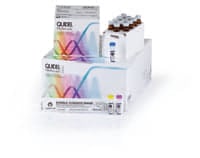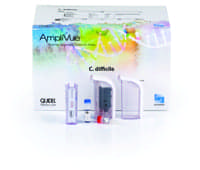 |
 |
 |
 |
|
Michael Bell, MD |
Pete Bantock Accelerate Diagnostics |
Douglas White OpGen Inc |
Yemi Adesokan, PhD Pathogenica |
Technologies go to the next level in diagnosing hospital-acquired infections
BY KAREN APPOLD
Each year, two million Americans go to the hospital to be treated for a known condition. Ten percent of these patients will contract a hospital-acquired infection (HAI)—and 100,000 of these people will die—more than twice the number of people killed by breast and colon cancers combined. This makes HAIs the fourth leading cause of death in the United States.
Unfortunately, this trend is steadily increasing because the pharmaceutical and laboratory diagnostics sectors have not been able to keep up with microbial evolution.
“Antibiotics have been used so widely that the infectious organisms they are designed to kill have adapted to them, making the drugs less effective,” says Michael Bell, MD, acting director, Division of Healthcare Quality Promotion, Centers for Disease Control and Prevention (CDC), Atlanta. “People infected with antimicrobial-resistant organisms are more likely to have longer, more expensive hospital stays, and may be more likely to die as a result of the infection. In fact, some bacteria have no antibiotic options left.”
Studies show that nearly 50% of antimicrobial use in hospitals is unnecessary or inappropriate. “Overusing antibiotics contributes to the growing challenges posed by Clostridium difficile (C. difficile) and the antibiotic-resistant bacteria in many hospitals,” Bell says. “However, studies also demonstrate that improving the use of antibiotics in hospitals can not only help reduce rates of C. difficile infection and antibiotic resistance, but can also improve individual patient outcomes, all while saving hundreds of thousands of dollars in healthcare costs.”
A dilemma

This situation occurs because extensive use of these drugs serves to promote the survival of new variant strains of bacteria that acquire resistance and thereafter have the liberty to spread their “successful” genes, Bantock says. The central issue, given the lack of major new antibiotic development, is the direct need for very rapid laboratory automation and assays that not only identify bacteria, but also rule in effective antibiotics before the physician initiates the second dose of antimicrobial therapy (in less than 8 hours after receiving a patient specimen).
The Quicker, the Better
It is preferable when infections can be detected and treated as early as possible. “Not only does that save lives and allow patients to get well sooner, but it also can reduce the risk that the infection will spread to someone else,” Bell says.
Very ill patients in the intensive care unit have depressed immune function. They are highly vulnerable to infections because of their underlying severe illness. “Studies have shown that switching antibiotics from an inactive drug to an effective drug makes little difference in outcome if delayed for even 24 hours,”1 Bantock says. “Additional studies have shown that with the most severely ill patients, mortality risk climbs 7.6% per hour of delay in starting effective therapy.”2
However, as important as early diagnosis is, accurate diagnosis is even more important. “Rapid tests for HAIs can lack sensitivity and are being replaced by more costly and complex molecular tests,” says Paul D. Olivo, MD, PhD, senior medical director, Quidel Corp, San Diego. “There is a need for molecular tests which are easier to perform and less expensive, but which retain a high degree of accuracy.”
Facilities that run surveillance programs based on complete genetic profiling of HAIs can enable more informed and proactive infection control practices to ensure a safe environment and mitigate the financial risks associated with unit closures and decontamination, says Douglas White, CEO, OpGen Inc, Gaithersburg, Md.
The Economic Burden of HAIs
Time is of the essence in reducing HAIs, not only from a healthcare perspective, but also for financial reasons. According to the CDC, the annual estimated cost of HAIs ranges from $28.4 billion to $33.8 billion.3 Government regulations are already decreasing reimbursement to hospitals for HAIs and will continue to do so. As a result of the Deficit Reduction Act of 2005, which became effective on October 1, 2008, Medicare will not reimburse for certain types of HAIs.4
The Affordable Care Act, which was also implemented in 2008, incentivizes hospitals to lower their readmission rates (which are often due to HAIs) and achieve better care on certain quality metrics. As of this year, hospitals get reduced reimbursement when their readmission rates exceed a certain amount.5 The program is funded by withholding payment from hospitals that perform poorly.
| CLICK HERE TO SEE THE SLIDESHOW THAT AUGMENTS THE PRODUCT INFORMATION BELOW. |
Testing for HAIs
In light of the impact of HAIs, laboratory technology manufacturers are stepping up to the plate to offer products that can quickly and accurately diagnose them. Here’s a sampling of what’s available now.
- Quidel Corp has developed the AmpliVue C. difficile assay, a molecular diagnostic test for C. difficile detection. The assay is an in vitro diagnostic test for the direct, qualitative detection of the C. difficile toxin A gene (tcdA) in unformed stool specimens of patients suspected of having C. difficile infection. “The assay utilizes isothermal helicase-dependent amplification to magnify a highly conserved fragment of the tcdA sequence, and a self-contained disposable amplification detection device allows for visual evaluation of assay results,” Olivo says. The small handheld molecular device requires less than 10 minutes of hands-on time; results are available within 90 minutes.
- Another offering from Quidel, the Molecular Direct C. difficile assay, is a real-time polymerase chain reaction (PCR) diagnostic test for the qualitative detection and identification of toxigenic C. difficile bacterial DNA. “The assay requires three steps for sample preparation and one step to set up reagents,” Olivo says. “No timed, heat, or vortexing steps are needed.” The simplified and uniform workflow with standard pipetting volumes takes less than 70 minutes. The assay can be stored refrigerated (2°C to 8°C) and set up at room temperature, eliminating the need for an ice or cooling block. The assay can be used on the Applied Biosystems 7500 Fast Dx, Life Technologies’ QuantStudioTM Dx Real-Time PCR instrument, and the Cepheid SmartCycler II.
- OpGen’s C. difficile DNA complete test is a diagnostic test that also rapidly diagnoses the presence of C. difficile. “Unlike other available tests, it also predicts the severity of a patient’s illness based on the genetic analysis of the pathogen,” White says. “Understanding which patients are more likely to have severe cases allows faster responses with the appropriate therapy and proactive infection control measures.”
- For outbreak surveillance and infection control, evidence shows that comparing ordered, genomic maps is the most accurate way to distinguish between outbreak isolates and sporadic infections. Unlike traditional microbial DNA fingerprinting methods, OpGen’s Whole Genome Mapping technology provides a rapid, comprehensive, highly discriminating method of strain typing, which also readily identifies and locates important genetic elements associated with virulence and drug resistance. “OpGen’s MapIt HAI Epi Services using Whole Genome Mapping will allow hospitals to better identify, analyze, and understand the genetic origins of microbial super bugs,” White says.
- The VITEK 2 microbial identification system from bioMérieux, Durham, NC, provides microbial identification as well as state-of-the-art antibiotic susceptibility testing. “The VITEK 2 includes an expanded identification database, rapid test results, improved confidence, and minimal training time,” says Nedal Safwat, PhD, director of global marketing. It produces the information clinicians need to match the right drug to the infectious pathogen.
- bioMérieux’s VIDAS and miniVIDAS instruments are multiparametric immunoassay systems designed to detect C. difficile and other pathogens. The VIDAS BRAHMS PCT assay measures the levels of procalcitonin in blood. This is a marker for bacterial infection and also serves as a predictive marker for sepsis.
| A Close Look at the Worst Culprits
C. difficile infections affect the intestines of people who have received antibiotics. The infection not only causes diarrhea, but can also damage the colon so severely that it needs to be removed. |
| Up and Coming
Although still under development, some technologies to detect hospital acquired infections (HAIs) are noteworthy. |
References:
1. Niederman MS. Use of broad-spectrum antimicrobials for the treatment of pneumonia in seriously ill patients: maximizing clinical outcomes and minimizing selection of resistant organisms. Clin Infect Dis. (2006) 42 (Supp 2): S72-S81.
2. Kumar A, Roberts D, Wood KE, et al. Duration of hypotension before initiation of effective antimicrobial therapy is the critical determinant of survival in human septic shock. Crit Care Med. 2006;34(6):1589-1596.
3. The Direct Medical costs of Healthcare-Associated Infections in U.S. Hospitals and the Benefits of Prevention. Division of Healthcare Quality Promotion National Center for Preparedness, Detection, and Control of Infectious Diseases Coordinating Center for Infectious Diseases Centers for Disease Control and Prevention March 2009.
4. Hospital-Acquired Conditions (Present on Admission Indicator). Centers for Medicare & Medicaid Services.
5. Readmissions Reduction Program. Centers for Medicare & Medicaid Services.
6. Making health care safer: Stopping C. difficile infections. Centers for Disease Control and Prevention.
RELATED READING:
“Health Care Reform to Boost Hospital Demand for Molecular Diagnostics“
“More Research Needed to Compare Effectiveness of MRSA Screening Strategies in Health Care Settings”
“Microbiology/Virology: Testing One for All“
Karen Appold is a contributing writer for CLP. For more information, contact Editor Judy O’Rourke, [email protected].


